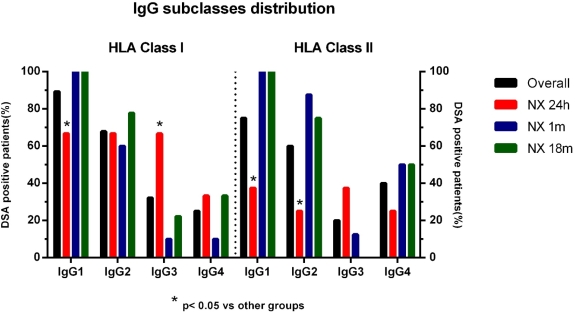IgG De Novo HLA Antibody Subclass Analysis in Patients Undergoing Allograft Nephrectomy after Transplant Failure
1Renal and Transplant Centre, Imperial College Healthcare NHS Trust, London, United Kingdom
2Histocompatibility and Immunogenetics, Imperial College Healthcare NHS Trust, London, United Kingdom.
Meeting: 2018 American Transplant Congress
Abstract number: C12
Keywords: HLA antibodies, IgG
Session Information
Session Name: Poster Session C: Histocompatibility and Immunogenetics
Session Type: Poster Session
Date: Monday, June 4, 2018
Session Time: 6:00pm-7:00pm
 Presentation Time: 6:00pm-7:00pm
Presentation Time: 6:00pm-7:00pm
Location: Hall 4EF
Introduction: different immunising events can stimulate the production of disparate antibody subclass profiles, reflecting a diverse extent of T-cell activation. Transplant nephrectomy (NX) is a known cause of donor-specific antibody (DSA) production after graft failure, and its effect on the generation of IgG subclasses has never been investigated.
Methods: 35 unsensitized patients who underwent first-graft NX were included and divided according to the timing of NX: group 1 (within 24h from implantation, n=11), group 2 (1-30 days after transplant, n=13), group 3 (1-18 months after transplant, n=11). Sera obtained 24 months after NX were assessed for IgG subclasses for HLA-A/B/Cw/DR/DQ using the single antigen Luminex assay.
Results: 9/11 patients in group 1, 10/13 in group 2 and 9/11 in group 3 were DSA positive at 24 months (p=n.s.). All four IgG subclasses were produced for both DSA classes (Figure1). Compared with the other groups, group 1 showed lower proportion of IgG1 and higher proportion of IgG3 positive patients for class I, and lower proportion of IgG1 and IgG2 positive patients for class II (Figure 1). Group 1 was also characterised by lower prevalence of patients generating DSAs with subclass profile 1-2– and 1— for class I (p=0.049 and 0.034), lower prevalence of the profile 1-2– for class II (p=0.019), and a tendency to lower prevalence of profile 1— for class II (p=0.097) compared to the other groups.
Discussion: our findings suggest that NX results in a continuous immunological stimulus leading to the production of all IgG subclasses up to 24 months later and regardless of the timing of the NX. The different distribution of the subclasses prevalence and profiles across the study groups may indicate that the early, within 24 hours NX is characterized by a different pattern of T-cell activation compared to NX performed later after the transplant.
CITATION INFORMATION: Lucisano G., Gueret-Wardle A., Brookes P., Santos-Nunez E., Firmin N., Gunby N., Hassan S., Willicombe M., Taube D. IgG De Novo HLA Antibody Subclass Analysis in Patients Undergoing Allograft Nephrectomy after Transplant Failure Am J Transplant. 2017;17 (suppl 3).
To cite this abstract in AMA style:
Lucisano G, Gueret-Wardle A, Brookes P, Santos-Nunez E, Firmin N, Gunby N, Hassan S, Willicombe M, Taube D. IgG De Novo HLA Antibody Subclass Analysis in Patients Undergoing Allograft Nephrectomy after Transplant Failure [abstract]. https://atcmeetingabstracts.com/abstract/igg-de-novo-hla-antibody-subclass-analysis-in-patients-undergoing-allograft-nephrectomy-after-transplant-failure/. Accessed December 23, 2025.« Back to 2018 American Transplant Congress

